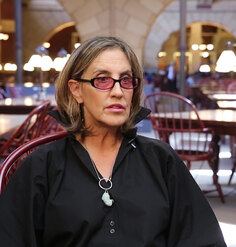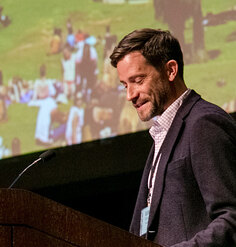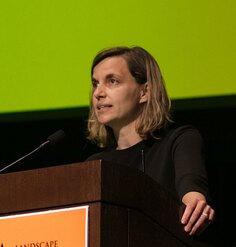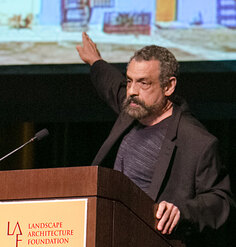Landscape Futures
By Gerdo P. Aquino
This presentation was part of the Landscape Architecture Foundation’s The New Landscape Declaration: A Summit on Landscape Architecture and the Future held in Philadelphia on June 10-11, 2016. LAF asked a diverse group of leading minds to write a “Declaration” reflecting on the last half century and offering bold ideas for how landscape architecture can make its vital contribution in response to the challenges of our time.
Gerdo P. Aquino
Firmwide CEO, SWA
Los Angeles, California
Gerdo P. Aquino is firmwide chief executive officer of SWA, a landscape architecture, urban design, and planning practice. Aquino is also adjunct associate professor at the University of Southern California. He holds a bachelor of science in landscape architecture from the University of Florida and a master of landscape architecture from Harvard Graduate School of Design.
* Affiliation at the time of the Summit
Landscape Futures
by Gerdo P. Aquino
"A person who never makes mistakes never makes anything." - Anonymous
As we ease into this century, our society is focused on reconnecting with ourselves, our ethnicity, our environment, and each other. In a traditional sense, our minds must be freed through the freedom of the body, and a park is a place where that can happen. A park is a place to unwind and reflect on things that matter most; a place for recreation to push the limits of the human body; and a place to understand nature and the spectrum of flora and fauna it supports.
Parks are at the core of what landscape architects do. The turn-of-the-twentieth-century Arcadian city park of green open lawns and axial cross paths has given way to twenty-first-century, highly designed, $20-million-an-acre, intensely programmed, public/private urban destinations, and we are just getting started. What will the twenty-second-century urban park look like? We can only imagine the possibilities.
Meanwhile, rapid advances in technology continue to deepen our understanding of the world by providing us with knowledge unimaginable just a decade ago: big data related to climate change and superstorms; drone-based high-resolution digital three-dimensional mapping of complex terrain to inform adaptive landscapes; and autonomous electric vehicles. Climatology experts predict that the recurrence of droughts in southwestern United States will continue into the foreseeable future with water distribution for agricultural industries, irrigation, and drinking water playing out in real time.
As our cities continue to become more dense, we can expect even stricter regulations on our natural resources to balance the needs and wants of their communities. The landscape of the future will be challenging to imagine. The next generation of landscape architects must integrate evolving technologies into the context of the city park, generating interesting and unique outcomes.
Park design in the twenty-second century will lie at the nexus of four important considerations: mobility, ecology, programming, and financing. As independent considerations, these are simple mechanisms achieving a singular result. However, as a combined system moving at the same pace as our culture, these very mechanisms could yield real breakthroughs for park design in the twenty-second century and further reinforce the role of the landscape architect as the lead consultant overseeing large, complex public realm projects.
The work of landscape architects today will serve as the foundation for future innovation. I am inspired by the work carried out around the world by our peers in design and engineering, and the arts and sciences. I am inspired by civic leaders who understand the role of the landscape architect in helping make their cities more livable. A project like the Buffalo Bayou Watershed Park in Houston, designed by SWA, began as a grassroots movement centered around local flooding and open space issues and, over the course of 20 years, evolved into a national precedent for resilient landscapes addressing superstorm capacity/conveyance while providing a flexible open framework of community programming, regional bike trails, and habitats for birds and mammals. It is also now a top destination in Houston, helping elevate the identity of the city itself.
I am inspired by the renewed interest in activating the public realm in our great American cities. El Paso, Texas, recently redesigned its defunct 100-year-old public plaza into a vibrant, active hub of cultural programming and the arts. At the core of the design process was a highly visible group of constituents pushing for a strong narrative in the park’s redesign, a narrative that would merge the past with the future while creating something entirely new—an emblem of the city’s desire to step far into the twenty-first century.
I am inspired by cities like Belgrade, Serbia, which, over the course of four years, will transform a 1¼-mile stretch of postindustrial waterfront along the Sava River into an iconic open space, reconnecting its historic core with its waterfront. The new waterfront will also address rising flood levels in the Sava River by integrating a modular flood protection system activated by the hydraulic action of the rising water levels in the river. Projects like this bring much-needed open space to the dense urban core of Belgrade and provide residents and tourists with a safe, one-of-a-kind destination in Eastern Europe.
I am impressed by Cairo, Egypt, where they are contemplating moving the existing capital to an area east of the urban core to relieve congestion and provide a new urban fabric for millions of people. Fundamental to this move is a unique infrastructure strategy that would use both the Nile River and the Suez Canal to provide fresh, clean, sustainable water sources to the new development. At the center of this proposal is a landscape architect whose planning and design vision must be bold and visionary in the context of the storied history of Cairo.
Finally, I am impressed with the younger generation of landscape architects around the world. Wherever my travels take me, I inevitably meet bright young designers with big ideas and, more often than not, imbued with the kind of confidence and charisma it takes to change the world. We need all of you to continue thinking big, to explore the future of the landscape in a projective, experimental way, unhindered by preconceptions or rules, to take some risks and fail along the way, only to pick yourselves up and become stronger. Landscape architects are the future. Believe it.











